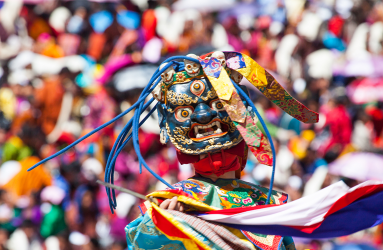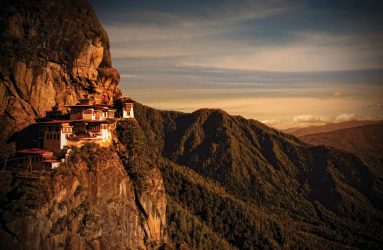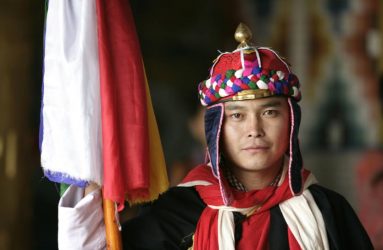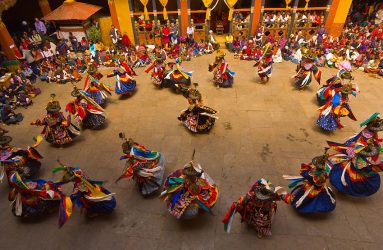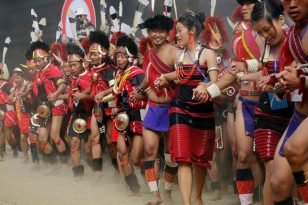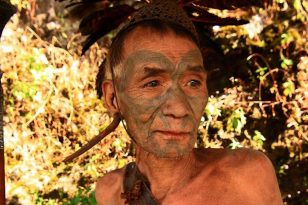| Tour Price | £ 3220 per person on twin sharing basis Single Supplement: Available at £ 350 internal flights from Delhi-Paro and Paro- Guwahati starting from £ 535 per person |
|
| Tour Dossier | Download Dossier | Booking Enquiry |
Embark on an unforgettable trip to the mystical kingdom of Bhutan steeped in ancient tradition, spectacular scenery, peaceful monasteries during Paro festival, the most important festival of Bhutan and witness the rich culture of this country. Then proceed to the North East Indian state of Assam to see the magnificent one horned rhinos and rich wildlife of the state and winding up with walks and hikes in the charming Khasi hills in the beautiful state of Meghalaya, where bridges are living, ingenuously built by the local tribes, a skill passed on from across generations.
Detailed Itinerary
Fly from Delhi to Paro, Bhutan. As you start approaching Paro, you can see breathtaking views of the Great Himalayas on either side from the plane. On arrival, you will be met by our Bhutanese tour guide, who will assist with immigration and custom formalities at the airport and thereafter, drive to Punakha. Located at the junction of Mo Chhu ( Mother river) and Pho Chhu ( father river), Punakha is a warm and fertile valley with scenic rice terraces and abundant banana and orange plantations. On your way, stop at Dochhu La Pass (3050 m) to enjoy the spectacular views of the mighty Himalayas and as you drive down further towards the valley you will be greeted by prayer flags in the scattered villages. Overnight at Punakha. (L,D)
Accommodation: Hotel Zangto Pelri or similar
In the morning after breakfast, visit the 17th century Punakha Dzong, the most beautiful and towering monastery in the entire country that served as capital and seat of Government till the 1950s. This remarkable fortress is an excellent example of monastic architecture that continues to stand formidably despite many fires, floods and earthquakes. Therafter, hike to Khamsum Yulley monastery and explore the farms and houses in the valley. Overnight in Punakha. (B,L,D)
Accommodation: Hotel Zangto Pelri or similar
Today, drive to Gangtey valley or Phobjikha Valley, a vast U-shaped glacial valley, named after the impressive Gangtey Monastery of the Nyingma sect in central Bhutan, where the graceful black-necked cranes in Bhutan (Grus nigricollis) from the Tibetan Plateau visit the valley during the winter season to roost. On arrival in the Phobjikha Valley in the last week of October, the black-necked cranes circle the Gangtey Monastery three times and also repeat the process while returning to Tibet. The broad valley with its best-known marshland in Bhutan is popular for its scenic splendor and cultural uniqueness. Visit Wangdue Phodrang. Overnight at Wangdue. (B,L,D)
Accommodation: Hotel Vera or similar
Drive from Wangdue to Thimphu and on the way, visit the Chimi Lhakhang monastery ( temple of madman), built in 1499 to commemorate Lama Drukpa Kinley’s subjugation of the demoness. It is also revered as a temple of fertility and a blessing ceremony with a giant phallus is performed for those who request this. Reach Thimphu by afternoon. Thimphu is the Capital and largest city of Bhutan, situated in the western central part of Bhutan. After reaching Thimphu by noon visit the King Jigme Wangchuk memorial chorten and in the evening walk the bustling streets of the capital city. Overnight in Thimphu. (B.L,D)
Accommodation: Hotel Pedling or similar
Today spend the entire day exploring the various highlights of Thimphu; visit Kuensel Phodrang, where you will see the Great Buddha Dordenma, Motithang Takin Preserve, Painting School or National Institute of Zorig Chusum, National Handicraft Emporium, TashichhoedDzong or Thimphu Dzong. Overnight in Thimphu.(B,L,D)
Accommodation: Hotel Pedling or similar
Drive to Paro and hike upto the historical Tigers Nest. Paro Taktsang also known as the Taktsang Palphug Monastery and the (Tiger’s Nest) is a prominent Himalayan Buddhist sacred site, located on the Cliffside about 900 meters above the Paro Valley. According to legend, the Tiger’s Nest got its name when Guru Rinpoche brought Buddhism to Bhutan, flew to this cave site on a tiger’s back and meditated here for a few months before building the monastery. The arduous hike navigates through oak and pine forests that opens up into a ridge from where you have magnificent views of the monastery. Thereafter visit the ruins of Drukgyal Dzong, built to commemorate the victory of Bhutan over Tibet in the 17th century. Overnight in Paro. (B,L,D)
Accommodation: Dewachen resort or similar
On days 7 & 8, after early breakfast, go for the Paro festival, the most important festival of Bhutan which draws thousands of locals from all parts of Bhutan, offering an excellent opportunity to see Bhutan’s rich culture and history. Overnight at Paro. (B,L,D)
Accommodation: Dewachen resort or similar
Today fly from Paro airport to Guwahati. Here our representative will receive you at the airport and from there drive straight to Kamakhya temple located in the Nilachal Hills overlooking the city of Guwahati on one side. Kamakhya temple is the most revered Shakti temple of the Goddess and is associated with a disturbing past as human sacrifices used to take place here in the past. Check in at your hotel and the rest of the evening at leisure. Overnight in Guwahati. (B,D)
Accommodation: Assamese homestay Baruah Bhavan
Kaziranga NP is world renowned as home to two thirds population of the world’s one horned rhino. The Park is divided into three regions- Western, Eastern and Central. The western range has maximum short grass areas, wetland, patches of tall grassland and woodland and is the optimum habitat for rhino and water buffaloes. The Eastern Range is situated towards the eastern part of the park, less frequented and the area is excellent for birding. It includes nesting of the globally threatened pallas’s fish eagle, spot-billed pelicans, migrant waterfowl, the drive through this range is very scenic and swamp forest elephants can be seen, as well as water buffalo and swamp deer. The Central region is characterised again by short grass and it gives an ideal introduction to the park and its ecology as the route passes through the entire spectrum of habitat types prevalent in the Kaziranga area. Sightings include elephants and other big animals especially the swamp buffalo and rhino. (B,L,D)
Accommodation: Borgos
Drive from the plains of Assam into the Khasi Hills of Meghalaya the ‘Abode of the Clouds’, abound by beautiful scenery and landscape of rolling hills lined with pine trees. During the journey you will have several stops to take in the beautiful scenery and finally reach your destination at Shillong, the capital of the state of Meghalaya. Here visit the various sites and spend time exploring the bustling Police Bazaar area. Overnight in Shillong (B,L,D)
Accommodation: Aerodene Cottage
Drive to Cherrapunjee and explore the charming plateau of the Khasi hills characterised by deep gorges, caves, thundering waterfalls and many folklores. On the way, hike the Laitlum canyons and visit the village of Smit, where the Syiem or the chief of the War khasi tribe resides. Also visit the Khasi monoliths and then reach Cherrapunjee. (B,L.D)
Accommodation: Cherrapunjee Holiday Resort
In the morning go on a trek to the double decker living root bridge. The living root bridges are ingeniously built bridges over streams and rivers from the roots of the rubber plant by a root guiding mechanism that takes decades to build and continue to function for centuries. These are built by the local War Khasi tribes and is a skill that is passed on from one generation to the next.
This is a day long trek as you will walk through meandering paths going downhill and enroute, you will come across little villages. The double decker bridge is one of its kind as there are two bridges stacked one over the other. If you fancy a dip in one of the natural pools at the bottom of the trek, carry your swimming costumes. Then you will start climbing uphill. Overnight in lodge in Cherrapunjee. (B,L.D)
Accommodation: Cherrapunjee Holiday Resort
In the morning go on an old trekking route, the David Scott trail discovered in the 1800s, which goes all the way from India and ends in Bangladesh. While the entire trek is 100 km., long, today you will walk only a part of it. The whole trek is blessed with mesmerising views, hamlets, streams and waterfalls. You will end your trek near Mawphlang, where you will be picked up by the car and then drive to your lodge. Overnight in tea farm stay. (B,L.D).
Accomodation: Camellia Tea farm stay
Drive to Guwahati airport for your onward journey home. Tour ends. (B).
Inclusions & Additional Information
- All meals as indicated above (B- Breakfast, L-Lunch, D- Dinner)
- 15 Nights’ accommodation on tour
- Bhutan visa
- All transportation
- Tour Guide including local guides in various location
- All entrance fees
- 02 Jeep and 01 elephant safaris
- All transfers
- Bottled water
We try to use the best accommodation available whichever place we go. In Bhutan your accommodation will be in Government approved hotels/ lodges equivalent to 3 star category hotels and farm stays, In North east India it will be homestays, lodges and farm stays.
Food is prepared using local, fresh produce in most places and maybe mildly spiced for Indian food, local cuisine, continental, Chinese is also available in some of the places. If you have any dietary requirements please mail us at the time of the booking and we will take care wherever possible.
We will be arranging Bhutan visa for you.
A passport (with at least six months remaining validity) and a current Indian visa are required for this trip. Please note that you are required to have a passport with a machine-readable bar code. You will need to apply for your Indian visa in advance from the relevant issuing authority in your home country. In UK, this is done by and agency VFS. Please visit the website
It is recommended that you take out appropriate insurance to cover personal accident, medical costs, repatriation, loss of baggage and holiday cancellation.
Please visit your GP for guidance for vaccinations and advice for prophylaxis against malaria. Please also visit this website for more details https://www.fitfortravel.scot.nhs.uk/destinations/asia-(east)/india.aspx
Assam will be dry and pleasant in the months of November- December with maximum temperature of 25 degrees and minimum of 10 degrees. The days will be mostly clear, sunny and bright. Nagaland will be relatively cold with night temperatures going down to 5 degrees. Light sweater or a jacket in Assam and warm clothing is recommended for Nagaland.
It is recommended to carry fleece/ jacket/coat, gloves and woollen hat as temperatures tend to drop in certain places especially in the mornings and at night. During the day, lightweight clothes will be fine. Comfortable shoes recommended as their will be moderate amount of walking.
The currency used is Indian Rupee. It is recommended to get your money exchanged on arrival at Delhi airport.

